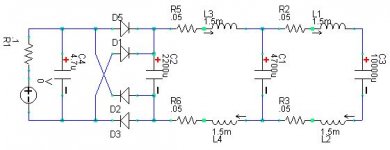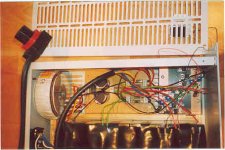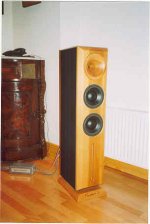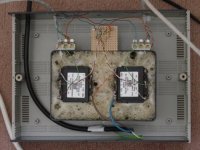Peter Daniel said:What charger are you using and having 8 batteries, is it complicated to switch it between them when charging?
I tend to get an allergic reaction to any thing complicated so generally my stuff is about as simple as it can be😉
At present my 4 batteries are shared between channels.
I leave them on charge when the amps are not in use
To charge them I use two 50 VA 9V+9V transformers with a cheap highish power bridge rectifier on each one. these are connected in series to give me 12V+12V+12V+12V ( in theory.)
lead acid batteries are not that fussy about charging regimes so long as they are not left discharged for long periods. If left on float charge they ideally like about 13.5V.
including losses & regulation %, my 50VA's give me about 12.8V at the end of a charging period. This will do fine for me but I guess 75 or 100VA would be more ideal.
I noticed you mentioned in another thread that you do not use fuses on the secondary side of your trannies. I hope you don't mind me mentioning that, IMHO, not using fuses with batteries is wreckless in the extreme. I have a small poly pro cap across each fuse.
I hope some of this is helpful🙂
cheers
mike
mikelm said:
I noticed you mentioned in another thread that you do not use fuses on the secondary side of your trannies. I hope you don't mind me mentioning that, IMHO, not using fuses with batteries is wreckless in the extreme.
I also think that with batteries, the fuses are a neccessity. Did you compare the sound with and without batteries? I have 4 batteries, but still didn't have a chance to try them😉
battery life
I have had these cells less than 1 year
in float mode they should last for about 3 years. As they age they keep their charge for less time but as mine are 7AH I would imagine that they will keep enough charge for my needs for longer than this.
mike
karma said:so they float at 13.5v how long have thay lasted?
how old are the cells?
I have had these cells less than 1 year
in float mode they should last for about 3 years. As they age they keep their charge for less time but as mine are 7AH I would imagine that they will keep enough charge for my needs for longer than this.
mike
Peter Daniel said:
Did you compare the sound with and without batteries? I have 4 batteries, but still didn't have a chance to try them😉
I had a battery supply lm3875 based balanced wkg system and I built a friend similar setup, mains powered, using lm1875's.
I used smallish low voltage transformers as chokes and ended up with the following which seemed to sound about the same as the batteries. ( the batteries had just the 10,000uF across them ). The 10,000uF in both cases are T network caps and the others are DNM slit foil so there is some serious filtration happening in the mains cct !
The 4.7uF across the TR secondary really improved the sound but with my newfound knowledge of snubber ccts ( after reading & spice simulation ) I would put 1uF in paralell with 4.7uF in series with 10ohms. This might mean I could get away with less inductors!
I am currently building another mains PSU to try the snubbers and I intend to buy a selection of other caps to try with battery & mains based systems.
What caps would you recommend that I should try ?
mike
Attachments
Peter Daniel said:What charger are you using and having 8 batteries, is it complicated to switch it between them when charging?
Here is a better detail of the charging circuit which is a current limiter lm317/337 followed by a voltage reg lm317/337 x 4 so that I charge each two bat in series at 27.6v.When I want to charge them I just switch the circuit on from the power switch at the back.The gc has two 3pdt switches to switch the dual mono rails and ground from battery to ac.You can also see the connector I use which is a heavy duty 8-way speaker type connector.I was ucomfortable using the more popular xlr type first of all because they are usually not more than a couple of amps rated and secondly they donot allow a thick 6 conductor cable to be attached easily.And of course I use fuses on the output of the batteries.I was very scared working with this circuit since the batteries are always "on".
By the way Peter are you going to keep your famous "promise"?
nice!
Very nice.
I'd love to hear the sound of that tweeter.
Can you send it to me?
Just joking...
My experience tells me that even a Motorola piezo tweeter plays beautiful sounds when you get the crossover right.
With no crossover it's awful.
Very nice.
I'd love to hear the sound of that tweeter.
Can you send it to me?

Just joking...
My experience tells me that even a Motorola piezo tweeter plays beautiful sounds when you get the crossover right.
With no crossover it's awful.
mikelm said:
What caps would you recommend that I should try ?
I'm using 1000/50v BG per rail. Didn't compare with anything else so far but the sound is good, so don't see a reason to look anywhere else either😉
Recently I ordered some BG 1000/50 BG N type and installed them in monoblocks. The sound is great, especially with my modified Marantz, but to see how they really compare, I have to try them out in one of my production amps. Will do that soon .
protos said:
By the way Peter are you going to keep your famous "promise"?
I almost started the lottery thread, but realised it will take 2 or 3 days to hit 200,000 views. I guess it's too late now. Anyway, I didn't feel comfortable copying Nelson Pass.
Hey!
Have you deleted the thread?! 😱
😱
I was waiting for a nice box and some BGs on my mailbox!
Hey JoeDirt, what have you said?
I didn't arrive on time...🙄
Peter Daniel said:
I almost started the lottery thread, but realised it will take 2 or 3 days to hit 200,000 views. I guess it's too late now. Anyway, I didn't feel comfortable copying Nelson Pass.
Have you deleted the thread?!
 😱
😱 I was waiting for a nice box and some BGs on my mailbox!

Hey JoeDirt, what have you said?
I didn't arrive on time...🙄
simple battery charger
Well this my simple battery charger.
One of the transformers was buzzing so I put the two of them in a box, filled up all the spare space with small graded stones and poured in polyeurathane resin. The bubbles were caused by some residual moisture on the stones !!!
now it works completely silently, stays nice and cool and get the batteries up to about 13.3V🙂
if batteries are new and in the same condition it would be possible to use 18+18 rather than 2x9+9
cheers
mike
Well this my simple battery charger.
One of the transformers was buzzing so I put the two of them in a box, filled up all the spare space with small graded stones and poured in polyeurathane resin. The bubbles were caused by some residual moisture on the stones !!!
now it works completely silently, stays nice and cool and get the batteries up to about 13.3V🙂
if batteries are new and in the same condition it would be possible to use 18+18 rather than 2x9+9
cheers
mike
Attachments
i know this sounds stupid, and has beed discused before, but do i increase or decrease the feedback resistor to increase the gain? i am using a 220k resistor at the moment, and wondered how far i can increase the gain safely. 

more or less ?
for a non-inverting amp gain = ( Rf / Rg ) +1
for an inverting amp gain = - Rf / Ri (input)
so you could try doubling Rf and see if you like what you hear... noise & distorion will also increase but stability should be better.
cheers
mike
Matttcattt said:i know this sounds stupid, and has beed discused before, but do i increase or decrease the feedback resistor to increase the gain? i am using a 220k resistor at the moment, and wondered how far i can increase the gain safely.
for a non-inverting amp gain = ( Rf / Rg ) +1
for an inverting amp gain = - Rf / Ri (input)
so you could try doubling Rf and see if you like what you hear... noise & distorion will also increase but stability should be better.
cheers
mike
Re: more or less ?
which is resistor Rf and which is Rg?
mikelm said:
for a non-inverting amp gain = ( Rf / Rg ) +1
for an inverting amp gain = - Rf / Ri (input)
so you could try doubling Rf and see if you like what you hear... noise & distorion will also increase but stability should be better.
cheers
mike
which is resistor Rf and which is Rg?
Let me guess here;
RG=Resistor to ground
Ri= series input resistor
Rf= "the resistor around the IC" or the one at the output of the IC.
??? 🙂
/Peter
RG=Resistor to ground
Ri= series input resistor
Rf= "the resistor around the IC" or the one at the output of the IC.
??? 🙂
/Peter
Hi MatttCattt
There's a bit of theory about this on my GainClone page - hopefully this might help answer your questions?
Cheers,
Mark 😉
There's a bit of theory about this on my GainClone page - hopefully this might help answer your questions?
Cheers,
Mark 😉
- Status
- Not open for further replies.
- Home
- Amplifiers
- Chip Amps
- This is not just another gainclone




